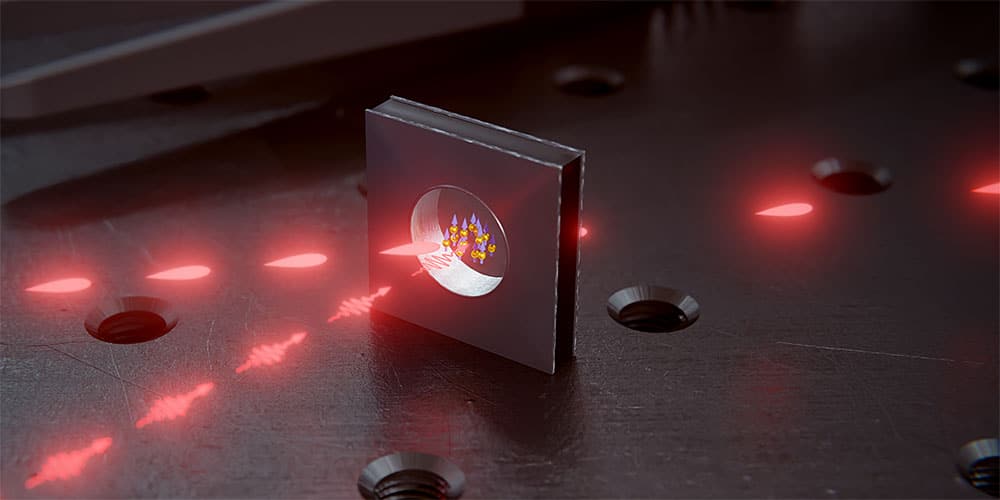Researchers at the University of Basel, led by Professor Philipp Treutlein, have developed a miniature quantum memory element that could be mass-produced. The memory element, based on rubidium atoms in a tiny glass cell, can store and retrieve light pulses, potentially enabling secure message transmission and connections between quantum computers. The team used a cell from the mass production of atomic clocks, heated to 100 degrees centigrade and exposed to a strong magnetic field, to facilitate quantum storage of photons. Treutlein plans to collaborate with the CSEM in Neuchatel to store single photons in the miniature cells.
Quantum Memory Development at the University of Basel
Researchers at the University of Basel, led by Professor Philipp Treutlein, have developed a quantum memory element based on atoms in a tiny glass cell. This development could pave the way for mass production of such quantum memories on a wafer. Quantum networks, similar to the internet or mobile phone networks, require memory elements for temporary storage and routing of information. The team’s results were recently published in the scientific journal Physical Review Letters.
Photon Storage in Miniature Glass Cells
The quantum memory element developed by the Basel team utilizes light particles, or photons, which are particularly suited to transmitting quantum information. Photons can be sent through fiber optic cables, to satellites, or into a quantum memory element. In this memory element, the quantum mechanical state of the photons must be stored as precisely as possible and, after a certain time, converted back into photons. Two years ago, the Basel researchers demonstrated this process using rubidium atoms in a glass cell. However, the cell was handmade and several centimeters in size.
Mass Production of Quantum Memory
The team, including postdoc Dr. Roberto Mottola, has now developed a method to use a much smaller cell, only a few millimeters in size, which they obtained from the mass production of atomic clocks. To have a sufficient number of rubidium atoms for quantum storage despite the small size of the cell, they heated the cell to 100 degrees centigrade to increase the vapor pressure. They also exposed the atoms to a magnetic field of 1 tesla, more than ten thousand times stronger than Earth’s magnetic field. This shifted the atomic energy levels in a way that facilitated the quantum storage of photons using an additional laser beam.
Achievements and Future Plans
The researchers were able to store photons for around 100 nanoseconds using this method. In that time, free photons would have traveled 30 meters. “In this way, we have built, for the first time, a miniature quantum memory for photons of which around 1000 copies can be produced in parallel on a single wafer”, says Treutlein. In the near future, Treutlein, in collaboration with the CSEM in Neuchatel, also plans to store single photons in the miniature cells. Moreover, the format of the glass cells still needs to be optimized, such as to store the photons for as long as possible while preserving their quantum states.
Original Publication
The original publication of this research, titled “Optical Memory in a Microfabricated Rubidium Vapor Cell”, was authored by Roberto Mottola, Gianni Buser, and Philipp Treutlein. It was published in the Physical Review Letters in 2023.
“Like their conventional counterparts, such quantum networks require memory elements in which information can be temporarily stored and routed as needed.” – Professor Philipp Treutlein
“Two years ago, the Basel researchers demonstrated this works well using rubidium atoms in a glass cell. However, that glass cell was handmade and several centimeters in size. To be suitable for everyday use, such cells need to be smaller and amenable to being produced in large numbers.” – Dr. Roberto Mottola
“In this way, we have built, for the first time, a miniature quantum memory for photons of which around 1000 copies can be produced in parallel on a single wafer.” – Professor Philipp Treutlein
Summary
Researchers at the University of Basel have developed a miniature quantum memory element, capable of temporarily storing and routing quantum information, which could be mass-produced in the future. The team achieved this by using a small cell from the mass production of atomic clocks, heating it to increase the vapor pressure of rubidium atoms for quantum storage, and exposing the atoms to a strong magnetic field to facilitate the quantum storage of photons.
- Researchers at the University of Basel, led by Professor Philipp Treutlein, have developed a miniature quantum memory element that could be mass-produced.
- The quantum memory element is based on atoms in a tiny glass cell and could be used in future quantum networks for secure message transmission and connecting quantum computers.
- The team used light particles, or photons, to transmit quantum information. The quantum state of these photons is stored in the memory element and can be converted back into photons after a certain time.
- The team previously demonstrated this process using rubidium atoms in a larger, handmade glass cell. The new development uses a much smaller cell, only a few millimeters in size, obtained from the mass production of atomic clocks.
- To facilitate quantum storage in the smaller cell, the team heated the cell to 100 degrees centigrade and exposed the atoms to a strong magnetic field. This allowed them to store photons for around 100 nanoseconds.
- The researchers aim to produce around 1000 copies of the miniature quantum memory on a single wafer. Future work will focus on storing single photons in the miniature cells and optimizing the format of the glass cells.

